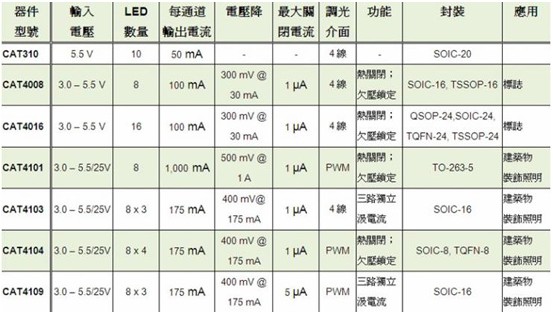With the improvement of LED in almost every aspect of illuminating performance, cost, etc., the application range of LED is more and more wide, but the penetration rate in various application fields is different. In commercial applications such as addressable signs and building lighting, LEDs are widely used for their advantages in color, total cost of ownership, longevity, reliability and convenience. For example, in building decorative lighting applications, the use of LEDs can create rich colors on the exterior walls of buildings and better reflect the structure of the building. In the action logo app, you can also instantly update traffic screens, video images and information on the billboard. Constant current intrusion type LED driver for applications such as LED signage
As the premier supplier of high-performance silicon solutions for energy-efficient electronics, ON Semiconductor offers a wide range of LED driver solutions for a wide range of LED applications, including addressable signs and building decorative lighting. A series of linear drives for common applications (see table below). These drivers accurately stabilize the LED current and include a programmable interface for software control. This article will take CAT4008, CAT4103 and CAT9552 as examples to illustrate their main functions and basic working principles, which is convenient for engineers' selection design.

Table 1: Series of Smart LED Controls/Drivers for ON Semiconductor Applications for Signage and Building Decoration Lighting
LED applications such as kanban signs, scrolling banners, smart vehicle signs, and sports scoreboards require multiple LEDs, often containing multiple strings of LEDs, requiring LED drive solutions to provide constant light output, and current matching accuracy between different channels. High, provide an easy-to-use interface to control different LED channels, and have reliable protection. ON Semiconductor's solutions for such applications include constant current LED intrusion drivers such as the CAT4008 and CAT4106, with the former supporting 8 channels and the latter supporting 16 channels.
Taking CAT4008 as an example, the typical LED channel matching accuracy is ±1.5%, and the LED channel can maintain a steady current state when the output voltage is as low as 0.4V (when the LED current is 2~100 mA), which can be realized in the application design. Higher power efficiency. The block diagram of CAT4008 is shown on the left side of Figure 1. For detailed function description of different pins, see Reference [1]. This component uses eight closely matched 汲 currents to stabilize the LED current for each channel, while the external resistor RSET is used to set the LED channel current to approximately 51 times the RSET current. Because each channel contains independent current sensing circuitry, the CAT4008 provides tight, steady current for all channels. The maximum voltage drop of the LED channel is 0.4 V under most current and supply voltage conditions, helping to improve heat dissipation and improve LED driver efficiency. At power-up, the undervoltage lockout circuit clears all latch and shift register information and sets all outputs to off. Once the undervoltage lockout threshold is reached, the component can be set. The driver delays the start-up time of each successive LED output channel by 17 nanoseconds (typical), that is, LED2 is delayed by 17 nanoseconds relative to LED1, LED3 is delayed by 34 nanoseconds relative to LED1, and so on. The delay is introduced when the latch (LATCH) pin is activated, minimizing the inrush current on the LED supply, allowing the use of smaller bypass capacitors.
The high-speed, four-wire (4-Wire) serial interface with speeds up to 25MHz controls each of the eight channels through the shift register and latch architecture. The serial data output pin allows multiple components to be used in series through the same serial interface. The CAT4008 also has an output shutdown pin that can be used to turn off all LED channels without having to rely on the serial port to send data. In addition, the CAT4008 features thermal protection to turn off the LED output when the die temperature exceeds the allowable limit.

Figure 1: Block diagram and application example of ON Semiconductor's 8-channel constant current LED intrusion driver CAT4008.